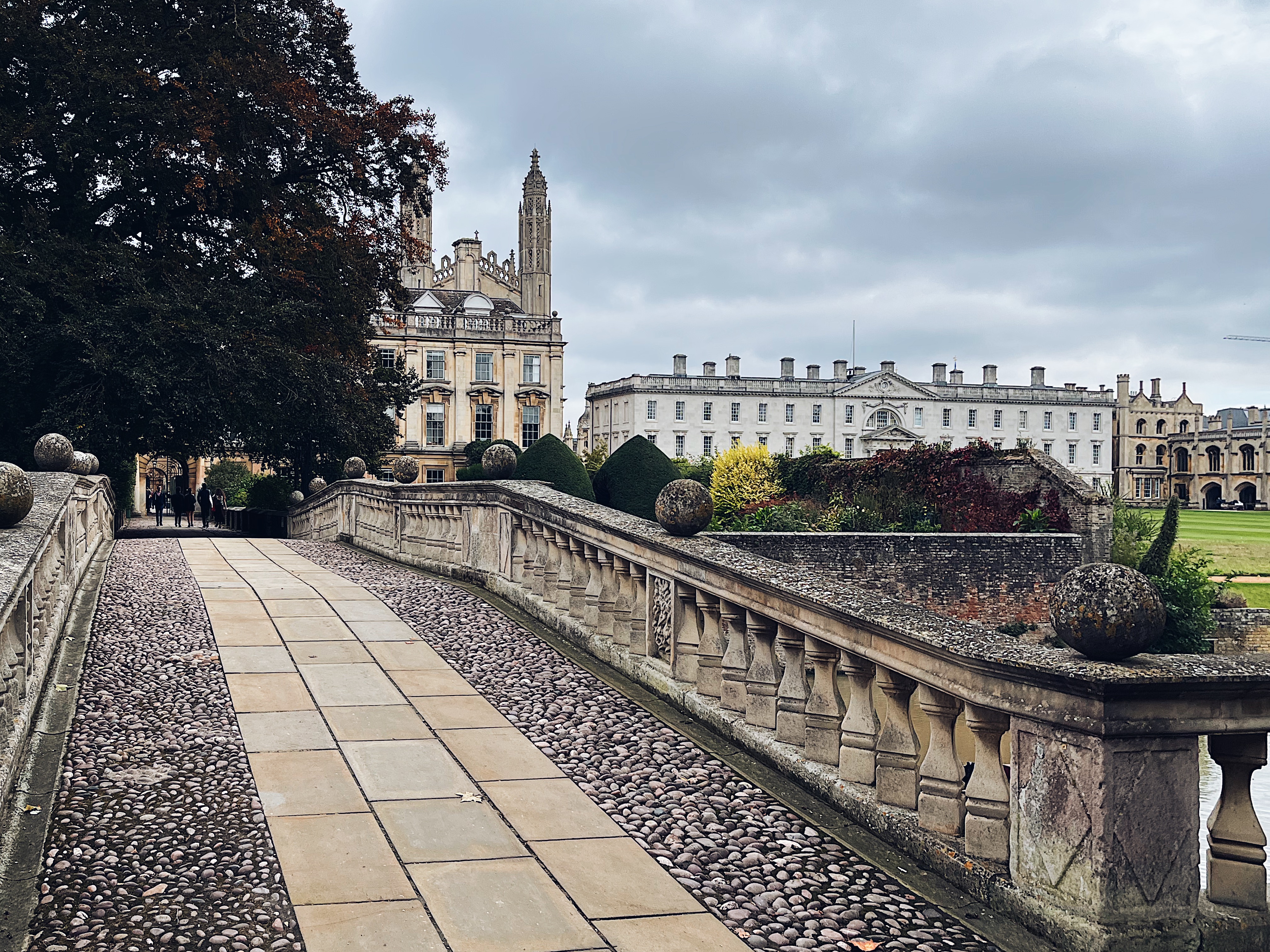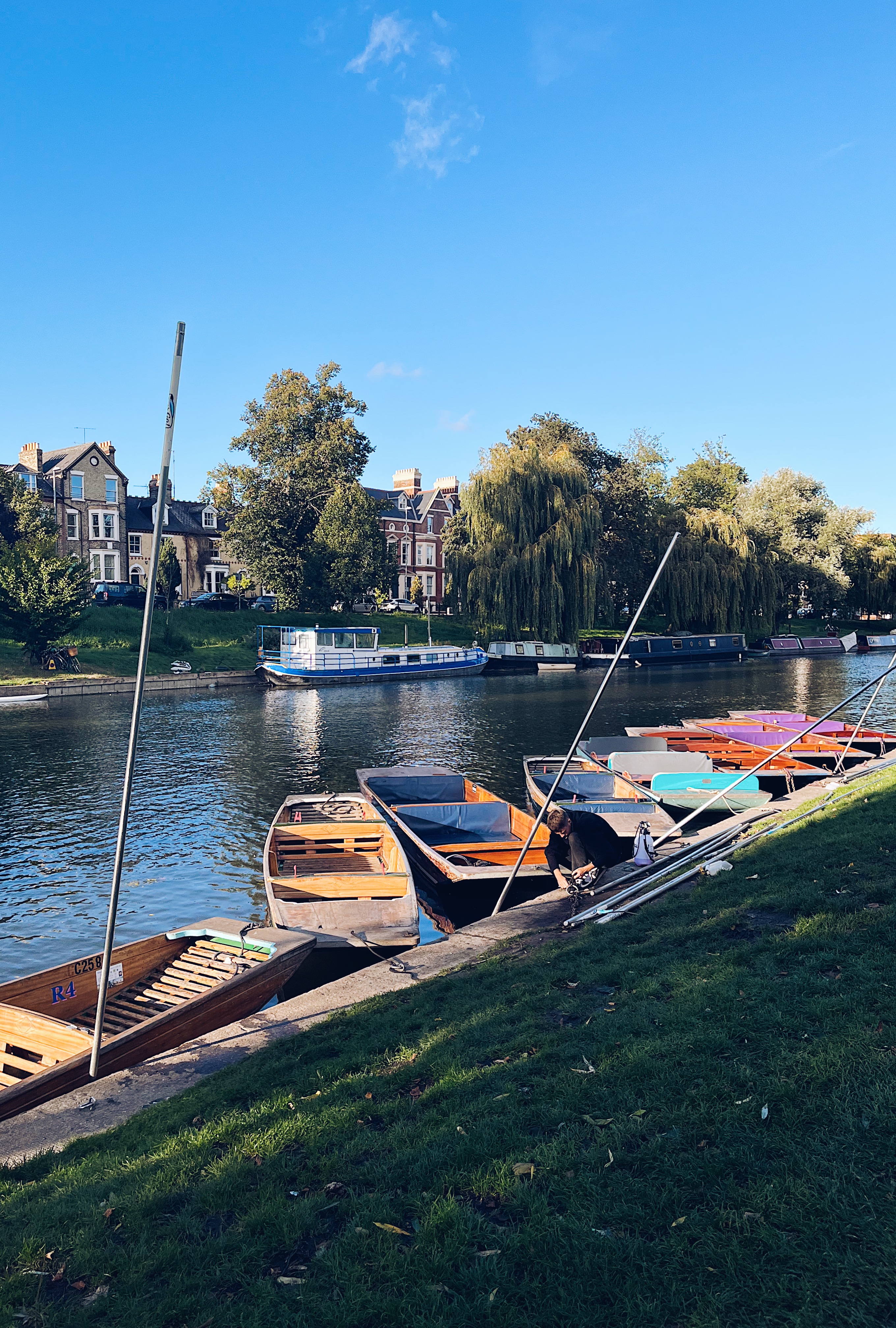Though my time in Cambridge was much shorter than I anticipated it would be, I still had three weeks to enjoy the beautiful city and soak up some of its history, now compiled in this simple travel guide. Cambridge, England is an incredibly photogenic location, perfect for walking or cycling, and full of diversity. From the colleges to the local cafes, it’s hard to visit this city (located about an hour north of London) and leave without feeling incredibly charmed.
The University of Cambridge Colleges

You can’t really go to Cambridge without seeing at least a few of the university’s colleges. Even if you don’t tour any of them, you will certainly pass a few while walking around town. There are 31 colleges in total, but visiting every single one may not be on your agenda, so make a point to research and plan accordingly. Among the university’s most magnificent colleges are King’s College, Trinity College, St. John’s, Pembroke, and Claire College. Other colleges, like St. Edmund’s and Claire Hall, though still beautiful, are a bit more modest and not as central to the city. They are still full of history and worth a visit if you have the time.

While visiting, you will likely find that each colleges has unique qualities and landmarks to distinguish them from one another. For example, The Corpus Clock (or “grasshopper clock”) is a unique feature of Corpus Christi College and can be found outside of its library while roaming the streets of the city center. Similarly, Trinity College is easily recognized by its Great Court, and King’s College stands out with its brilliant chapel.

In addition to landmarks and features, the libraries at each college are different and contribute to their brilliance. The Gonville and Caius Library, Wren Library (Trinity), Pepys Library (Magdalene College), and Old Library (St. John’s) are general favorites. Such libraries contain many ancient materials, like the Parker Library of Corpus Christi College, which houses the St. Augustine gospels. Many of these libraries are currently closed to the general public but may be accessed by appointment for research purposes.
The River Cam
Another iconic feature of Cambridge is, of course, the River Cam. This river, which divides the city and flows around it, is one source of vibrant activity. From punting to picnics, the river is a great place to explore and spend time near. If you go on a punting tour, you can see the Bridge of Sighs (St. John’s) and the Mathematical Bridge (Queens’ College). Both are recognizable landmarks crossing over the river in the city.
Cambridge Parks

Very accessible to the public, the Jesus Green is a large park located in central Cambridge. It’s perfect for walking shortcuts and strolls away from the busier scene of the city center. In addition to being absolutely beautiful, the parkland is perfect for getting active, having picnics, reading a book, or contemplating serious life decisions (can’t relate at all…). I think every city needs a place like this, where we can escape the crowds and inhale fresh air.
I spent a considerable amount of time exploring this part of Cambridge. Because I had to stay in a hotel for my first three days (thanks, Covid) and it was located just across the River Cam from the Jesus Green, this park was one of the first places I came to enjoy, along with its connecting streets and shops. Once I had a university lecture schedule and essay questions, I would often make lunch to bring with me and eat in the park while working on my papers.
There are several additional greens in Cambridge open to the public and perfect for walking. The Midsummer Common is Cambridge’s historic grassland, connecting to Jesus Green; The Backs is an accessible park located outside of Queens College and beside Queens’ Green, which provides a stunning view of King’s College from across the River Cam; and more central parks include Parker’s Piece, Christ’s Pieces, and New Square Park. You will likely venture through all of these and more at some point during your time in Cambridge.
Cambridge University Botanic Garden
The Cambridge University Botanic Gardens is another outdoor experience worth participating in. This garden is only about a 15-minute walk from the city center and isn’t far from a variety of other shops. The main purpose of the garden is for teaching and research, but it’s also open to the public for roughly £8 per adult and free for children. With over 8,000 plant species from various places throughout the world housed in this garden, you may consider it worth a visit when you travel to Cambridge.
Cambridge Market Square and Grand Arcade
Just south of the Jesus Green and not far from Gonville and Caius College is the Cambridge Market Square. This is an outdoor market with several food, art, and clothing stalls. You can visit 10am-4pm every day to find a very colorful and lively scene. There are also several surrounding shops worth exploring apart from the market stalls.
Honestly, it was the smell of food that led me to this outdoor market (it’s always the food). They have stalls of cheese, bread, gyros, fruit, dessert waffles, and more, but if the food isn’t enough to draw you in, perhaps you will find some unique souvenirs to take home with you. From handmade jewelry to musical instruments, I found the art stalls quite beautiful and impressive. The market isn’t very large compared to other popular public markets but still managed to leave a good impression and fill many of my days in Cambridge.
Apart from the Cambridge Market Square, additional shopping avenues can be found throughout the city and in the Cambridge Grand Arcade. This shopping mall is, not surprisingly, a leading shopping center in Cambridge and contains a variety of shops and eateries. The Grand Arcade also houses the Cambridge Central Library (because why wouldn’t there be a library in the mall? It’s Cambridge).
Fitzwilliam Museum and More
Many locals insisted on me visiting the Fitzwilliam Museum before flying back to the States. Not only do they have several events and exhibitions throughout the year, this museum is home to several remarkable art collections and ancient objects. Entry to the museum is completely free. You can book a visit for specific times on the museum website and stay until close, or receive walk-up tickets upon your arrival (though you may have to wait in line). The museum even has tickets available for visually impaired individuals, in which you can be guided on a touch tour. If you choose to visit, make sure you allow yourself ample time to explore and admire each unique gallery.






The city of Cambridge is also home to a variety of other museums. Among these are the Sedgwick Museum of Earth Sciences, the Museum of Archaeology and Anthropology, the University Museum of Zoology, the Cambridge Museum of Technology, the Whipple Museum of the History of Science, the Museum of Classical Archaeology, and the Museum of Cambridge, which contains details of Cambridgeshire history. Each museum website provides a brief history of its collection and entry requirements, though it is (unfortunately) unlikely that you’ll be able to visit and spend much time at each one. If you have to choose, make sure the Fitzwilliam Museum is near the top of your list.
University of Cambridge Library
Prepare to be overwhelmed. The library building itself is massive and the collection of materials held here is breathtaking. It’s very easy to get carried away and find yourself a bit lost. Whatever your area of interest is, you will likely find a section here that captures and supports it.
Borrowing materials and browsing the library’s special collections is possible with a membership. Otherwise, study spaces are open to the general public, in addition to the modern collections. There is no charge for this, though you may have to leave your bag in a locker before entering (and they will provide a clear bag for you to carry as you venture through the library).

Libraries have always been magical places to me, not only because of the fictional stories they may hold, but also because they provide an endless source of knowledge. Touring the library was both humbling and inspiring as it holds over 9 million items. I highly recommend being humbled by the University Library when you travel to Cambridge, especially if you are in academia or appreciate history.
Evensong at King’s College Chapel
This was another activity highly recommended by the locals of Cambridge, including those with no religious affiliation. King’s College Chapel itself is both magnificent and intimidating, and the service held within its walls was chilling. You can purchase tickets to simply tour the chapel and its grounds, though it’s incredibly special if you can also experience the hymns being sung by the choir. As this was one of the last things I did while in the city, it was a very bitter sweet experience.
Local Churches and Cathedrals
Finally, you can’t go wrong visiting a few medieval churches in the city. Great St. Mary’s, St. Andrew the Great, and The Round Church are easy to find while touring the city center. The Round Church, as one of the four medieval round churches still in use in England, is one of the most iconic buildings in Cambridge and is open to the public for a small entrance fee. You can also participate in a guided walk for £12 (adult). Similarly, you can climb Great St. Mary’s tower for about £6 and experience a panoramic view of the city.
There are also many churches less central to the city but easy to find nonetheless. For example, Little St. Mary’s Church can be found near Peterhouse College and caught my attention when I heard the choir singing inside. It provided a peaceful moment for me, away from the busy hustle of the streets.

I love thinking of all the events that happened in places like these — the conflicts, the awakenings, the worship, the fellowship. Such events are one of the main reasons Cambridge is an extraordinary place to travel to and go for study. I hope you will find yourself there one day to experience its magic, and please tell me about it if you do. <3
